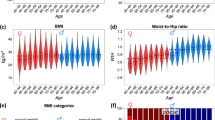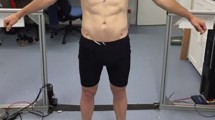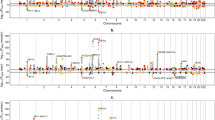Abstract
Background/Objectives
Body size and shape have increased over the past several decades with one in five adolescents now having obesity according to objective anthropometric measures such as weight, height, and body mass index (BMI). The gradual physical changes and their consequences may not be fully appreciated upon visual inspection by those managing the long-term health of adolescents. This study aimed to develop humanoid avatars representing the gradual changes in adolescent body size and shape over the past five decades and to align avatars with key BMI percentile cut points for underweight, normal weight, overweight, and obesity.
Participants/Methods
Participants included 223 children and adolescents between the ages of 5 and 18 years approximately representative of the race/ethnicity and BMI of the noninstitutionalized US population. Each participant completed a three-dimensional whole-body scan, and the collected data was used to develop manifold regression models for generating humanoid male and female avatars from specified ages, weights, and heights. Secular changes in the mean weights and heights of adolescents were acquired from six U.S. National Health and Nutrition Surveys beginning in 1971–1974 and ending in 2015–2018. Male and female avatars at two representative ages, 10 and 15 years, were developed for each survey and at the key BMI percentile cut points based on data from the 2015–2018 survey.
Results
The subtle changes in adolescent Americans’ body size and shape over the past five decades are represented by 24 male and female 10- and 15-year-old avatars and 8 corresponding BMI percentile cut points.
Conclusions
The current study, the first of its kind, aligns objective physical examination weights and heights with the visual appearance of adolescents. Aligning the biometric and visual information may help improve awareness and appropriate clinical management of adolescents with excess adiposity passing through health care systems.
Trial registration
ClinicalTrials.Gov NCT03706612.
This is a preview of subscription content, access via your institution
Access options
Subscribe to this journal
Receive 12 print issues and online access
$259.00 per year
only $21.58 per issue
Buy this article
- Purchase on Springer Link
- Instant access to full article PDF
Prices may be subject to local taxes which are calculated during checkout






Similar content being viewed by others
Data availability
Data described in the manuscript, code book, and analytic code will be made available upon request pending application and approval by the investigators.
References
Abdullah A, Stoelwinder J, Shortreed S, Wolfe R, Stevenson C, Walls H, et al. The duration of obesity and the risk of type 2 diabetes. Public Health Nutr. 2011;14:119–26.
Abdullah A, Wolfe R, Stoelwinder JU, de Courten M, Stevenson C, Walls HL, et al. The number of years lived with obesity and the risk of all-cause and cause-specific mortality. Int J Epidemiol. 2011;40:985–96.
Simmonds M, Llewellyn A, Owen CG, Woolacott N. Predicting adult obesity from childhood obesity: a systematic review and meta-analysis. Obes Rev. 2016;17:95–107.
Fryar CD, Carroll MD, Afful J. Prevalence of overweight, obesity, and severe obesity among children and adolescents aged 2–19 years: United States, 1963–1965 through 2017–2018. NCHS Health E-Stats 2020.
Fryar CD, Carroll MD, Afful J. Prevalence of overweight, obesity, and severe obesity among adults aged 20 and over: United states, 1960–1962 through 2017–2018. NCHS Health E-Stats 2020.
Heymsfield SB, Wadden TA. Mechanisms, pathophysiology, and management of obesity. N Engl J Med. 2017;376:254–66.
Liu J, Li Y, Zhang D, Yi SS, Liu J. Trends in prediabetes among youths in the us from 1999 through 2018. JAMA Pediatr. 2022. https://doi.org/10.1001/jamapediatrics.2022.0077.
Dietz WH, Robinson TN. Clinical practice. Overweight children and adolescents. N Engl J Med. 2005;352:2100–9.
l’Allemand-Jander D. Clinical diagnosis of metabolic and cardiovascular risks in overweight children: Early development of chronic diseases in the obese child. Int J Obes. 2010;342:S32–6.
Wong MC, Ng BK, Kennedy SF, Hwaung P, Liu EY, Kelly NN, et al. Children and adolescents’ anthropometrics body composition from 3-d optical surface scans. Obesity. 2019;27:1738–49.
Wong MC, McCarthy C, Fearnbach N, Yang S, Shepherd J, Heymsfield SB. Emergence of the obesity epidemic: 6-decade visualization with humanoid avatars. Am J Clin Nutr. 2022;115:1189–93. https://doi.org/10.1093/ajcn/nqac005.
Fryar CD, Kruszon-Moran D, Gu Q, Carroll M, Ogden CL. Mean body weight, height, waist circumference, and body mass index among children and adolescents: United states, 1999-2018. Natl Health Stat Report 2021:1–24.
Ogden CL, Fryar CD, Carroll MD, Flegal KM. Mean body weight, height, and body mass index, United States 1960–2002. Adv Data. 2004:1–17.
Ng BK, Sommer MJ, Wong MC, Pagano I, Nie Y, Fan B, et al. Detailed 3-dimensional body shape features predict body composition, blood metabolites, and functional strength: the shape up! Studies. Am J Clin Nutr. 2019;110:1316–26.
Wong MC, Ng BK, Tian I, Sobhiyeh S, Pagano I, Dechenaud M, et al. A pose-independent method for accurate and precise body composition from 3d optical scans. Obesity. 2021;29:1835–47.
CDC Division of Nutrition, Physical Activity, and Obesity. Growth chart training: Overview of the cdc growth charts: Division of Nutrition, Physical Activity, and Obesity, National Center for Chronic Disease Prevention and Health Promotion, U.S. Department of Health and Human Services; 2021. https://www.cdc.gov/nccdphp/dnpao/growthcharts/training/overview/page1.html.
R Core Team. R: a language and environment for statistical computing Vienna, Austria: R Foundation for Statistical Computing; 2021. https://www.R-project.org/.
Kennedy S, Smith B, Sobhiyeh S, Dechenaud ME, Wong M, Kelly N, et al. Digital anthropometric evaluation of young children: comparison to results acquired with conventional anthropometry. Eur J Clin Nutr. 2022;76:251–60.
Funding
This work was partially supported by National Institutes of Health NORC Center Grants P30DK072476, Pennington/Louisiana, P30DK040561, Harvard, and R01DK111698, Shape UP! Kids.
Author information
Authors and Affiliations
Contributions
Authors’ contributions to manuscript: JB, MCW, CM, NF, and SBH designed research; JB, MCW, CM, JS, and SBH conducted research; JS and SBH provided essential materials; JB, MCW, CM, NF, JS, and SBH analyzed data; JB, MCW, CM, NF, KQ, JS, and SBH wrote the paper; JB, MCW, CM, NF, KQ, JS, and SBH had primary responsibility for final content.
Corresponding author
Ethics declarations
Competing interests
SBH is on the Medical Advisory Board of Tanita Corporation and he is an Amazon Scholar. The other authors and their close relatives and their professional associates have no financial interests in the study outcome, nor do they serve as an officer, director, member, owner, trustee, or employee of an organization with a financial interest in the outcome or as an expert witness, advisor, consultant, or public advocate on behalf of an organization with a financial interest in the study outcome.
Additional information
Publisher’s note Springer Nature remains neutral with regard to jurisdictional claims in published maps and institutional affiliations.
Supplementary information
Rights and permissions
About this article
Cite this article
Bennett, J., Wong, M.C., McCarthy, C. et al. Emergence of the adolescent obesity epidemic in the United States: five-decade visualization with humanoid avatars. Int J Obes 46, 1587–1590 (2022). https://doi.org/10.1038/s41366-022-01153-9
Received:
Revised:
Accepted:
Published:
Issue Date:
DOI: https://doi.org/10.1038/s41366-022-01153-9



